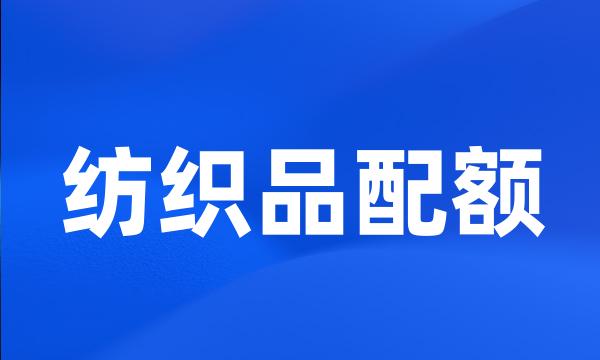纺织品配额
- 网络textile quota
 纺织品配额
纺织品配额-
随着中国加入WTO以及纺织品配额的取消,绿色贸易壁垒这一非关税壁垒逐渐成为发达国家对我国纺织品出口设置的主要贸易障碍。
With China 's entry into WTO and abolishment of textile quota , green trade barrier , the non-tariff barrier , has growing into a main trade barrier which developed countries throw in export of China 's textiles .
-
纺织品配额取消与中国纺织品出口剖析
The Analysis of Cancellation of Textile Quota and Chinese Textile Export
-
全面取消进口纺织品配额,意味着147个WTO成员国的纺织品出口不再受过去配额的困扰,可以开始自由贸易,这将极大促进中国纺织业的发展。
The cancellation of quota meant that the 147 WTO members will not be disturbed by the quota quantity limit again .
-
2005年1月1日,WTO各成员国正式取消了全球纺织品配额限制,标志着纺织品服装行业进入自由贸易时代。
From January 1,2005 , WTO members abolished all limits of textiles quotas , which is regarded as a token of textiles & garments industry entering the era of free trade .
-
2005年1月1日纺织品配额制度全面取消后,面对发展中国家纺织品出口的大量增加,纺织品进口国更频繁的使用WTO反倾销法来抑制此种趋势。
Since January 1st of 2005 , the arrangement of textile has been cancelled . Facing the rapid increase of developing countries ' export of textile , the textile import countries are getting used to relying on WTO 's Anti-dumping law to depress this trend .
-
纺织品配额:鸡肋?馅饼?
Production of Soybean Milk Textile quotas chicken ribs ? Pie ?
-
纺织品配额的取消促进了纺织服装业的贸易自由化。
Textile quota removal promotes trade freedom of global T & A industry .
-
纺织品配额分类和计量单位以有关协议规定为准。
The classification and measurement unit of textile quotas shall be based on relevant agreements .
-
南通应该采取积极措施来应对纺织品配额的取消。
So Nantong should take various positive measures to deal with the removal of textile quotas .
-
在全球纺织品配额制度取消以后,我国的纺织品出口贸易将面临巨大的挑战。
Abolition of global textile quota system in the future , China 's textile exports will face a huge challenge .
-
分析了取消纺织品配额后,纺织企业面临的人才需求结构的重大变化。
In this paper are analyzed the significant changes in personnel demand structure that textile enterprises face with after quota removal .
-
尽管2005年1月1日全球纺织品配额的取消给我国纺织品出口带来了福音,出口市场扩大了,出口量增加了。
With the textile quota cancelled on January 1, 2005.China has managed to expand the overseas market and increased the volume of exports .
-
前言:2005年1月1日起纺织品配额在全球范围内取消,世界纺织品行业进入“后配额时代”。
From January1st , 2005 , the abolish of textile quota in the world leads to the arrival of " No Quota Time " .
-
受美国和欧洲取消纺织品配额的推动,去年,印度纺织和服装出口额增长19%,达到160亿美元。
Helped by the abolition of US and European quotas , India textiles and apparel exports rose 19 per cent to $ 16bn last year .
-
纺织品配额取消以后,我国纺织服装出口反而遇到前所未有的挑战,纺织服装的低成本优势正在逐步丧失。
Since the cancellation of textile quota , China 's textile and garment export is facing with unprecedented challenge , and its low-cost edge is decreasing .
-
随着纺织品配额的逐步取消,绍兴的纺织业在迎来机遇的同时,也将面临更加激烈的竞争。
With textile quotas are being phased out , the textile industry in Shaoxing greet opportunities at the same time , they will face more intense competition .
-
外经贸部配额许可证事务局(以下简称“许可证局”),经外经贸部授权,系纺织品配额签证机关。
The Quota License Affairs Bureau under the MOFTEC ( hereinafter referred to as " QLAB ") is the issuing authority of textile quotas authorized by the MOFTEC .
-
全球纺织品配额体系于2004年宣告结束,催生了一波中国出口热潮,这引发了欧洲国家和美国的抵触情绪。
The end of a global quota system for textiles in 2004 has created a boom for Chinese exports , provoking a backlash in European countries and in the US .
-
2005年1月1日纺织品配额被取消,对于我国经贸界来说是一件历史性的大事。
It is a historic event in Chinese economic field that the textile quota system was cancelled on Jan 1st , 2005.And Europe and USA limited the import of Chinese textiles afterwards .
-
自1月份取消全球纺织品配额以来,对于如何应付快速增长的中国服装出口,产业界和欧盟成员国分别持两种对立观点,曼德尔森先生对此左右为难。
Since january , when worldwide textiles quotas were scrapped , Mr Mandelson has been caught between competing views among industry and EU member states about how to deal with booming Chinese clothing exports .
-
特别是2005年纺织品配额制度取消后,长期受到配额限制的中国纺织品服装出口理应得到一个很好的发展机遇。
After the abolition of textile quota system in 2005 , the export of textile and clothing , which had been limited for a long time , should have been developing soundly with this opportunity .
-
面对2005年纺织品进口配额的取消,WTO成员各有思考,无论是处于成本相对劣势的发达国家,还是处于技术相对落后的发展中国家,对中国纺织品的出口潜力都特别忧虑。
Facing the descending of textile import ration , the members of WTO began to consider the new condition . There especially are worries about the export potential of Chinese textile products , among both advanced countries for relatively high cost , and among developing countries for relatively backward technology .
-
纺织品进口配额的取消与中国面临挑战的思考
The Rescinding of Textile Import Ration And the Challenge Facing China
-
对策纺织品无配额时代
Countermeasures to Textiles No - quota Era
-
源自世界纺织品贸易配额取消后,各种新形式的贸易保护方式接踵而来。
From the abolition of quotas in the world textile trade , new forms of trade protection methods follow .
-
从2005年起美国和欧盟取消纺织品进口配额,中国纺织服装企业将面临前所未有的发展机遇。
From the year of 2005 , the USA and EU will cancel the textile import quota and the textile clothing enterprises in China will meet developing opportunities that have never been had before .
-
随着中美之间多数纺织品的配额被取消,以及中国纺织品的质量大幅提高,我预计到我的欧洲业务可能会下滑。
With the end of quotas between China and the US on most textile products , and the sharp increase in quality levels of Chinese fabrics , I anticipated a possible downfall in my European business .
-
2005年1月1日国际纺织品贸易配额制度取消,这对中国纺织品行业来说无疑是一个利好的消息,中国纺织品企业正准备最大限度占领国际市场。
It is absolutely good news for textile industry of China , because the global quota system of textiles has been abolished since January 1 , 2005 . Chinese textile enterprises will take the opportunity to occupy the world market to the full extent .
-
纺织品贸易取消配额,从此WTO进入一个没有配额的时代。
With the cancellation of the quota of textile trade , WTO enters to the no-quota time .
-
2005年1月1日,WTO成员的纺织品和服装配额全部被取消,但这并不意味着成员国对我国纺织品和服装的出口限制会完全取消。
On January 1 , 2005 , the WTO members ' textile and the clothing quota were cancelled completely , but this did not mean that from 2005 , the members can export and import textile and clothing without limit .
